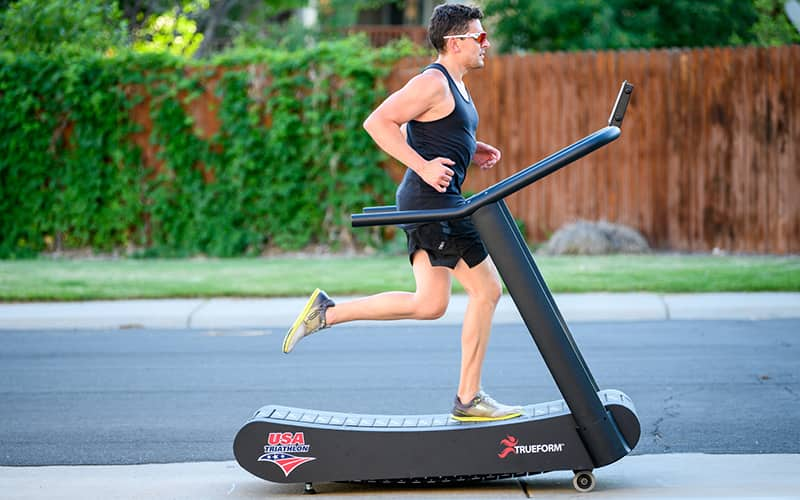
5 ways to Improve Run Gait using a TrueForm Treadmill
by Parker Spencer

Photo Credit: TRiRig
At-home workouts have never been more popular than they are in 2021 due to gyms across the country being closed due to the COVID-19 pandemic. According to the Washington Post, treadmill sales increased by 135% in 2020. Running outside is not always an option for people. Whether you are a busy parent getting your run in during your child’s nap time, or a business executive with a packed schedule getting in an early morning run, treadmills continue to be convenient and efficient way to tackle both technique training and calorie burn.
TrueForm treadmills are built to give the runner an efficient run that is as similar to running outside as possible. With its unique curved base and motorless design, it allows the runner to focus solely on their technique and effort, including their running gait. Running gait is another way of saying running form. You want your running form to be working for you and not against you. One of the first things you notice in an Olympic runner is how effortless they make running look. That is not just because they are incredibly fit, but also because they have worked at perfecting their running form. Just about anyone can improve their running form and practice better technique.
A treadmill is a great tool to hone in your running gait.Below are five ways you can use the TrueForm treadmill to improve your running gait.
Body Lean
Stand tall with your head in a neutral position, looking forward, not down. Your body lean will have a direct effect on your center of gravity and therefore your stride (where your foot lands in comparison to your body position). It is ideal for a distance runner to have a 3-5% body lean. If you are running too upright, it will hurt your momentum as well as your foot plant. Likewise, if you are leaning too far forward it can reduce your knee drive and also have a negative effect on your momentum. When you are leaning too far forward, your hips do not have as much room for flexion. Another term for knee drive is flexion angle.
Cadence
Most runners should focus on a cadence of 180 foot plants per minute or faster (90 RPM). A slower cadence than that will result in too much ground contact time and will increase fatigue as well as risk of injury. Many argue that proper cadence is the result of proper technique in other areas, but if you focus on an ideal cadence, it can improve other aspects of your run that also need improvement. A treadmill is an ideal place to work on this.
Foot Plant
A proper foot plant is when you land on your mid foot and directly under your center of gravity. You want your foot to have a slight backwards motion before it hits the ground. Meaning, before your foot hits the ground, your entire leg starts traveling backwards. This is a key component to maximizing your momentum. If your foot goes straight down from your knee drive instead of a backwards motion before it hits the ground, it will inhibit momentum and cause you to work harder to maintain speed. Many times, runners will over stride and their foot will land in front of their center of gravity. This is like pushing on the brakes every time your foot hits the ground. With every foot plant you are essentially slowing down and must work harder to maintain your speed and momentum. Proper foot plant is much easier to focus on when you are stationary on a treadmill.
Hip Stability
Hip stability is a common problem in runners. If you run without proper form your body begins to overcompensate certain muscle groups. Lake of hip stability is one of the major culprits to running-related injuries. Aside from key strength exercises, focusing on hip stability can go a long way in strengthening your run and insuring you are using proper form. You want to avoid your hips dropping side to side. In many runners you will also see one hip drop more than the other. A weak core can also be a reason for this. Focusing on a strong core and stable hips will reduce injury risk and improve performance.
Arm position
Many runners might not think too much about their arm position, but it is important in maintaining momentum and reducing inefficiently. You do not want your arms to cross over your center line and sway too much side to side. You want your momentum to go forward and if your arms are crossing over it will cause too much left to right motion which can also affect your hip stability. Instead of focusing on your arm motion forward, focus on driving your elbows directly behind you and naturally let them come forward. Do not clinch your fists; let your hands relax. Your arms should also be around a 90-degree angle for the most efficient arm position.
Parker Spencer (Tempe, AZ) is a USA Triathlon Level III Certified Coach and current head coach of USA Triathlon’s Project Podium. He is also a certified exercise physiologist through the American College of Sports Medicine. He came to USA Triathlon from his alma mater, Liberty University, where he served as the head coach of the men’s swimming and diving, men’s and women’s cycling, and men’s and women’s triathlon teams. In addition to his role at Liberty, Spencer held various positions with Endorphin Fitness from 2012-16 including as director of coach operations, head coach of adult programs and Junior Elite High-Performance Draft Legal coach. In his first two years as the Project Podium head coach, Parker’s athletes have two World Cup top five finishes, six continental cup podium finishes (21 top 10 finishes), one junior continental championship podium finish, one Pan American Games qualifier, four Junior/U23 World Championship qualifier and one Tokyo Olympic Test Event qualifier.